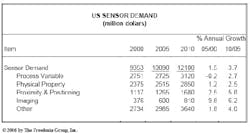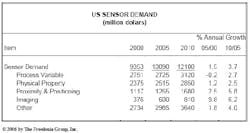U.S. sensor demand to exceed $12 billion in 2010
The fastest growth will occur in sensors based on more advanced, sophisticated technologies and those sensors likely to be used in dynamic applications such as automotive safety and security systems, medical equipment, military and aerospace equipment, and information technology.
Products such as advanced proximity and positioning sensors, optical chemical sensors, complementary metal-oxide semiconductor (CMOS) and thermal imaging sensors hold especially good prospects through the end of the decade, the study finds. Demand for certain types of physical property sensors, particularly those utilizing advanced technologies -- such as speed sensors based on micro-electromechanical systems (MEMS) technology -- is also expected to advance at well above the pace of the overall market.
Imaging sensors will see the fastest demand growth of any major sensor product category through 2010, rising 6.2 percent annually. Moreover, value gains understate the unit growth that will be achieved in the face of relentless price declines. Imaging sensors are integral components of numerous high-growth electronic products including cellular phones, digital cameras, electronic toys and games, and the like.
Proximity and positioning sensors will also see above average gains. The large automotive market will drive much of the growth, as safety products such as side airbags continue to achieve greater penetration, thereby increasing demand for related sensing products. In addition, more advanced occupant position and crash detection sensors will continue to penetrate the US motor vehicle market, although these technologies are not expected to become as widespread as airbags. Beyond the motor vehicle sec tor, proximity/positioning sensor demand will be supported by the ongoing recovery in the industrial sector -- the other significant market for these products.


